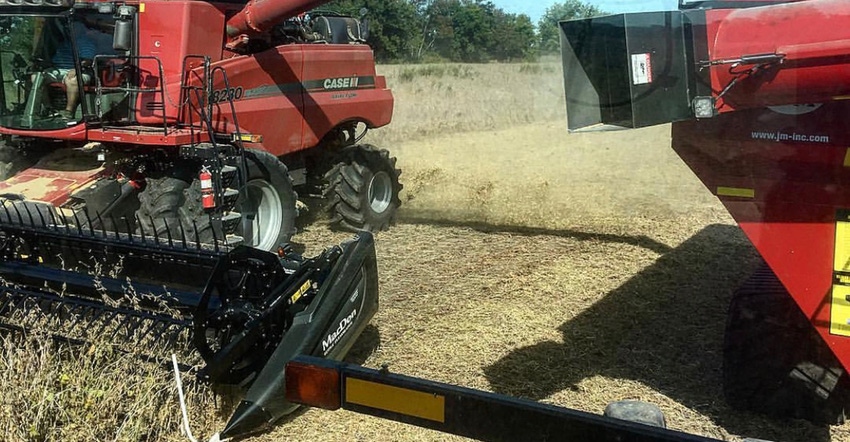November 24, 2017

By Hunter McGraw and Khyleigh North
For the past few years, farmers have been questioning if applying a fungicide to their soybeans is worth the time and money. Now that more farmers and researchers are testing the waters, what is the verdict?
The answer you get may depend upon whom you talk to about fungicides. Not everyone has the same opinion.
Here is a closer look at what farmers and agronomists are saying about soybean fungicides this winter.
What farmers say. Austin Woodward, a corn and soybean farmer from Noblesville, Ind., has been using fungicides on his family’s operation for four years now. Woodward says they’ve been applying fungicides on a third of their soybeans and have either broke even or made money by doing this.
“Timing is crucial when applying; we always try to apply right at R3,” Woodward says. “It’s something that we aren’t going to stop doing.”
Woodward also says his 2017 soybean crop that was treated with a fungicide averaged about 10 bushels per acre better than his nontreated soybeans.
On the flip side, Pat McGraw, a corn and soybean farmer from Attica, Ind., isn’t sold on the idea of yearly application.
“We’ve either broke even or haven’t seen much of a return,” McGraw says.
McGraw says they will continue to apply on a need-to basis. But for now, it doesn’t make sense all the time, he observes. Like people say, he adds, “why fix something if it isn’t broken?”
Where diseases could be an issue. There are multiple ways soybeans can become more susceptible to diseases. Moisture, heavy rainfall and cooler temperatures during the growing season can provide the perfect environment for pathogens to grow.
Average rain, the right amount of sunshine and heat can all also influence disease. According to Purdue University Extension botany and plant pathology specialists, diseases such as frogeye leaf spot and brown spot are seen most in soybeans and have the most harmful effects on a crop.
What risks are involved. Timing, resistance and no return on investment are things that all come to mind when farmers are thinking about applying fungicide.
Studies done by Beck’s in its Practical Farm Research program stress that timing is crucial when applying fungicides. After the R4 stage of soybean growth, there is hardly any return on investment for applying fungicides.
Resistance can build up if fungicides aren’t used properly. There’s always a risk of not physically seeing a return on investment in farming.
What experts say. Yearly application of fungicides at R3 can increase plant respiration and allow the plant to use water more efficiently, according to Travis Burnett, agronomist for Beck’s in Atlanta, Ind.
Burnett says the plant is then able to senescence and die on its own. This can allow the soybean to catch a few extra rains, which could increase seed size, impacting final yield by up to 30%.
A variety of factors can influence whether a farmer should use foliar fungicides. Even though disease might not be present, fungicides do more than eliminate disease, Burnett says.
Bryan Overstreet, an Extension ag educator in Jasper County, Ind., worries that disease could build resistance if fungicides are used year after year when thresholds aren’t met. He says if that happens, there might not be a product to combat a disease when farmers really need it.
“At R3, it should be late enough in the season to tell if you need to spray or not,” Overstreet says.
Burnett says there are ways to manage fungicide resistance. By using different modes of action, the likelihood of developed resistance goes down, he notes.
Using just one mode of action year after year could potentially build up resistance. Compared to weeds, pathogens reproduce more quickly. Newer fungicides offer two modes of action, which lowers the risk of resistance.
Could yearly applications increase yields? Studies done by Beck’s have shown that by applying fungicides yearly, you can increase soybean yield and see a profitable return on investment.
Soybean diseases require a susceptible host, the right environmental conditions and the pathogen to produce a disease. Some diseases may not be visible until several weeks later. Fungicides can potentially eliminate the disease and provide a return on investment.
Zero in on application timing. Applying at R3 and applying only once have shown the best results, experts say. R3 is the growth stage where adequate water and nutrient reserves are critical because the pod and seeds are developing. Any stress that may be put on the plant could reduce yield.
At R3, 60% to 75% of the flowers are shooting out, the canopy isn’t fully closed, and you can get down to where the pathogens are. After closure of the canopy around R4, it can be very difficult to treat fields effectively with fungicides.
From R4 to R6, the plant finishes flowering. After that, it can no longer produce pods. During this time, if the plant undergoes any stress, yield will be impacted directly.
What about ROI? When soybean prices are low, it’s even more important to boost yields. With minimal disease throughout the year, farmers still see a return on investment because their soybeans stay alive longer and catch extra rains. This observation is based largely on Beck’s Practical Farm Research work.
Beck’s PFR team has done a seven-year study on fungicide application to soybeans. The multiyear study has shown a $17-per-acre average return on investment.
Is annual application your best bet? Fungicides aren’t the cure-all for soybean fields, but they could potentially increase yields, experts believe. When considering the yearly application of fungicides, risk, time, benefits and money are all variables to consider. You must answer the question: “Is it worth it for your field?”
McGraw and North are seniors in the Purdue University Ag Communication program. Pat McGraw is the co-author’s father.
You May Also Like




